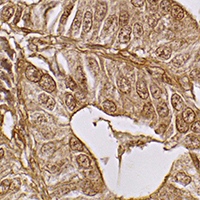Immunopositivity for Siglec-15 in gastric cancer and its association with clinical and pathological parameters

Submitted: 23 August 2020
Accepted: 9 February 2021
Published: 4 March 2021
Accepted: 9 February 2021
Abstract Views: 1745
PDF: 845
Supplementary: 154
HTML: 6
Supplementary: 154
HTML: 6
Publisher's note
All claims expressed in this article are solely those of the authors and do not necessarily represent those of their affiliated organizations, or those of the publisher, the editors and the reviewers. Any product that may be evaluated in this article or claim that may be made by its manufacturer is not guaranteed or endorsed by the publisher.
All claims expressed in this article are solely those of the authors and do not necessarily represent those of their affiliated organizations, or those of the publisher, the editors and the reviewers. Any product that may be evaluated in this article or claim that may be made by its manufacturer is not guaranteed or endorsed by the publisher.
Similar Articles
- Jiancai Ouyang, Fuhu Song, He Li, Rui Yang, Haicheng Huang, miR-126 targeting GOLPH3 inhibits the epithelial-mesenchymal transition of gastric cancer BGC-823 cells and reduces cell invasion , European Journal of Histochemistry: Vol. 64 No. 4 (2020)
- V Cebasek, L KubÃnová, S Ribaric, I Erzen, A novel staining method for quantification and 3D visualisation of capillaries and muscle fibres , European Journal of Histochemistry: Vol. 48 No. 2 (2004)
- A Corriero, F Acone, S Desantis, D Zubani, Histological and immunohistochemical investigation on ovarian development and plasma estradiol levels in the swordfish (Xiphias gladius L.) , European Journal of Histochemistry: Vol. 48 No. 4 (2004)
- N Marziliano, E Arbustini, M Rossi de Gasperis, S Crovella, Detection of Epstein Barr virus in formalin-fixed paraffin tissues by fluorescent direct in situ PCR , European Journal of Histochemistry: Vol. 49 No. 3 (2005)
- M Artico, E Bronzetti, L Saso, LM Felici, A D'Ambrosio, F Forte, C Grande, F Ortolani, Immunohistochemical profile of some neurotransmitters and neurotrophins in the seminiferous tubules of rats treated by lonidamine , European Journal of Histochemistry: Vol. 51 No. 1 (2007)
- G Abban, NB Yildirim, AM Jetten, Regulation of the vitamin D receptor and cornifin beta expression in vaginal epithelium of the rats through vitamin D3 , European Journal of Histochemistry: Vol. 52 No. 2 (2008)
- C Sarasquete, E Gisbert, L Ribeiro, L Vieira, Mt Dinis, Glyconjugates in epidermal, branchial and digestive mucous cells and gastric glands of gilthead sea bream, Sparus aurata, Senegal sole, Solea senegalensis and Siberian sturgeon, Acipenser baeri development , European Journal of Histochemistry: Vol. 45 No. 3 (2001)
You may also start an advanced similarity search for this article.

 https://doi.org/10.4081/ejh.2021.3174
https://doi.org/10.4081/ejh.2021.3174










